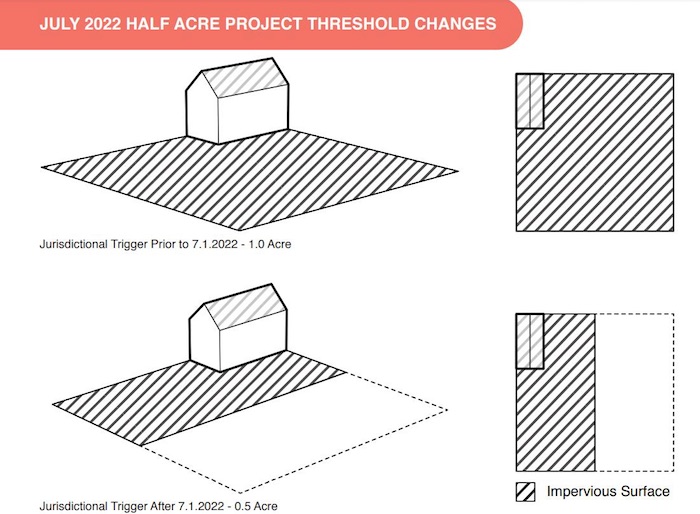Montpelier, Vt. — On December 1, 2020, the Vermont Department of Environmental Conservation (DEC) issued the Stormwater General Permit 3-9050(bit.ly/SW-3-9050) to help protect Vermont waterways. The permit regulates stormwater discharges or runoff from impervious surfaces (any hard or solid surfaces like roofs, roads, and parking lots where water runs off instead of soaks in). Within the 2020 permit, the DEC listed activities that require permit coverage, including the new development or redevelopment of ½ acre or more of impervious surface starting July 1, 2022.
“Stormwater runoff not only erodes our soils but also carries sediment, phosphorus, and other pollutants into our waterways,” said DEC Commissioner John Beling. “Issuing this permit is a key part of the Vermont Clean Water Act of 2015. Vermont needs to reduce stormwater runoff from commercial, industrial, residential, and institutional properties to meet clean water goals.”
Property owners must apply for General Permit 3-9050 for stormwater discharges or runoff from the following types of projects:
- A new development with a ½ acre or more of impervious surface. New development is construction of an impervious surface on a tract or tracts of land where no impervious surface previously existed. *
- A redevelopment of an existing impervious surface if the redeveloped part of the existing impervious surface totals a ½ acre or more. *
- An expansion of an existing impervious surface, such that the resulting impervious surface totals 1 acre or more.
- Projects with impervious surfaces of 3 or more acres that meet the definition of an “impervious surface of three or more acres” in General Permit 3-9050 and as described in Subpart 1.3(D) of the General Permit.
- Projects that were previously permitted for discharges of stormwater runoff and must renew permit coverage due to the expiration of the permit.
* Projects are impacted by the lowered ½ acre threshold that took effect on July 1, 2022.
Projects starting new development or redevelopment of ½ acre or more acres of impervious surface are not subject to the lowered ½ acre threshold if one of the transition exemptions in General Permit 3-9050(1.5)(F) is applicable. The previous threshold of 1 acre or more of impervious surface for new development and redevelopment applies for these projects.
In 2019 and 2020, the DEC offered opportunities for the public to comment on the ½ acre threshold. The ½ acre threshold can be found in the Chapter 22 Stormwater Permitting Rule (bit.ly/VT-SW-Rule) since it’s effective date of March 15, 2019, and in the General Permit 3-9050 since its effective date of December 1, 2020.
“With the ½ acre threshold for permit coverage that took effect in July 2022, Vermont can better manage stormwater, improve water quality, protect natural resources, and safeguard human health,” said Beling.
Licensed professional engineers must prepare all permit applications. To find an engineer, property owners and members of the public may use a list of firms (bit.ly/SW-firms) that have sent permit applications in the past.
For more information, read about the ½ acre threshold and transition exemptions (bit.ly/VT-half-acre). The Stormwater Management Program (bit.ly/VT-SMP) oversees regulations and offers technical assistance for stormwater management. If Terry Purcell is not available, contact Michael Sadler at 802-490-6159 or Michael.Sadler@vermont.gov.
The Vermont Clean Water Act of 2015 assures consistency with the applicable requirements of the federal Clean Water Act of 1972. Coincidentally, today is the 50th anniversary of the federal law and this action is representative of how Vermont continues to uphold and work towards its shared vision of reducing pollution that enters rivers and lakes from their source.




Years ago, I worked on clean water in the USDA. We all understood that point sources (from a pipe) could be cleaned up, and it was common knowledge that there was not enough money in the entire USA to control non-point sources, but here is the DEC thinking they can. Its past time to fire the entire herd in that agency, and hire smart people for what really needs to be done.
Of course there is no mention of costs for this new bureaucratic money pit. Just the alleged promise of ‘cleaner water’ somewhere in the future.
Compliance with these ‘rules’ is big money. Just the permit review costs are big money- and it’s not just shouldered by big business, shopping malls and car dealers. Coming to a small housing development near you (or maybe the one you live in)…
It’s almost funny to listen to politicians decry the lack of ‘affordable housing’ in Vermont- and that the ‘state’ needs to spend more to help…
While we all want clean water, this ain’t more help for affordable housing.
I cain’t take it no mo’….the idiocy and the COST of Enviro Democrat policies…the lies, the falsehoods, the “feel good”. Just like this fixation on stormwater runoff and by making people spend $$$$ to update their parking lot drains will cure it? LIE! The BIGGEST POLLUTER of stormwater runoff IS THE STATE OF VERMONT THEMSELVES! How? There are 7,200 MILES OF BLACKTOP PAVED ROADS IN VT….On these roads the STATE has no runoff or drainge protection and they totally slather these roads with salt, chemicals, sand etc in winter….and almost ALL these roads of major trafiic do what? THEY WERE BUILT TO FOLLOW RIVERS AND STREAMS!. Look at Rt 2, Rt. 14, or Rt 89 or Rt 91….they all follow rivers and EVERY INCH of these STATE BLACKTOP roads washes off as stormwater….INTO some RIVERS – that drain into Lake Champlain? SO WHO IS DOING THE STORMWATER POLLUTING? Your tiny parking lot, NO WHERE near Lake Champlain? Or State of VT’s 7,200 miles of blacktop, much of which directly DRAINS into Lake Champlain?? CALCULATE the square footage of 7,200 miles of DOUBLE WIDE blacktop roads…and you will find who the real polluter is with blacktop runoff!
You can’t fix stupid 🙂
17,454 acres using 20’ for road width.